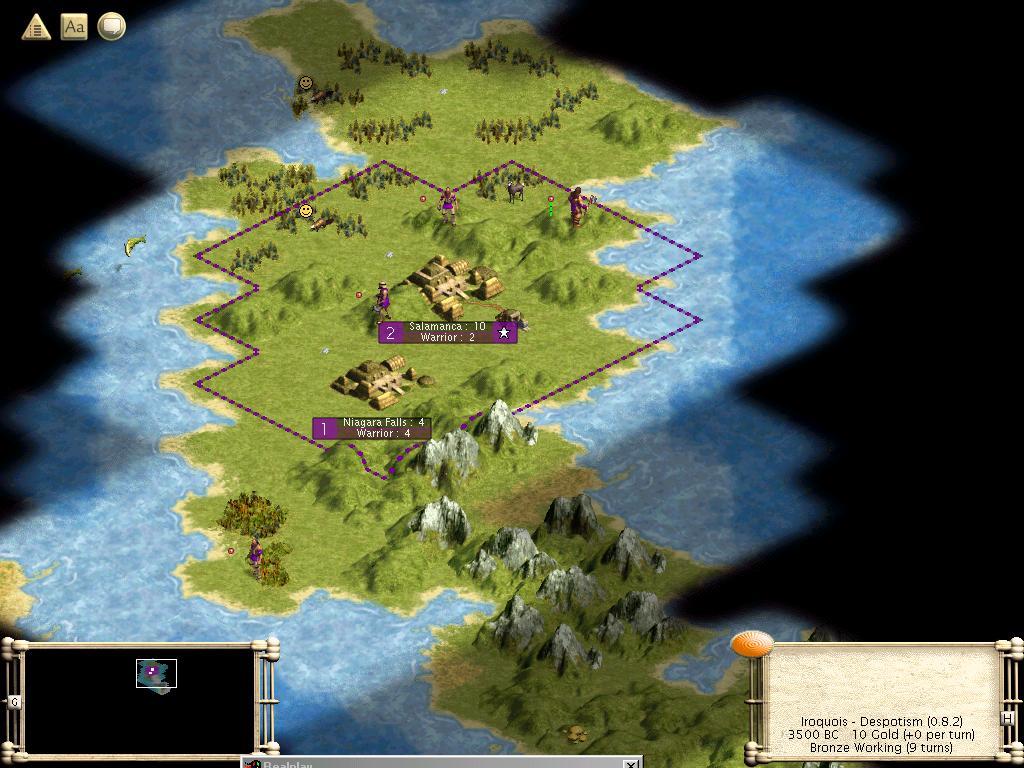

This was the situation in 3500BC. Notice the fact that I already have two decent cities when I would otherwise have only one.

I am producing warriors to deal with the threat of barbarians. As I was to discover eventually, the random setting for barbarians was actually chosen as "off", making these early warriors, when production is the most critical, pretty much useless. You can also see just how small and rugged the starting postition is; I would eventually fit four more cities above the mountains, but that was with some pretty serious tile sharing. Another problem was the complete lack of fresh water for irrigation, something that slowed down growth quite a bit. Granaries were able to offset this, but only to a certain extent. I'm not sure why these pictures are coming out fuzzed either; they are perfectly clear before they get loaded onto the geocities server. I suspect it is because of the cheap nature of this free webspace.
Here's where some of my less intelligent decisions start coming into play. I did not capitalize fully on my immense early luck of the goody hut settler, and thus did not claim as much land as I should have reached. The plan I should have followed (easy to see in retrospect) would have been to build a barracks in the capitol and used it to build military and city improvements, while Niagra Falls built a granary and focused on producing settlers every 10-15 turns. This would have produced much better results than what actually happened, which was a somewhat disjointed production of a bunch of early warriors, three initial scouts (which WAS a good move; maybe I should have had even more) and the truly weedy move of building a barracks before a granary in Salamanca (with settlers mixed in here periodically). Let me state this more clearly: if the starting position is a low-food region, it is critical to build a granary ASAP in the starting city. This will increase growth 10-fold over the long term. Well, it's something for me to consider in my next game at least.
The first city I built with my own settler was placed to the north, on the tile NE of the hill. This was a good spot, as it could use its own bonus grassland and interchange with the capitol for a game forest. After a temple was built, it could use a whale tile out in the sea as well (in the black on this map). This city eventually became a major powerhouse in terms of shields and commerce. Other cities were built in a circular pattern - well as much as possible - around the capitol, though most were greatly restricted in growth before harbors were constructed.
I should probably mention a little bit about tech research here. I went full blown research all the way to start, 100% science as long as possible without going broke. What prompted me to do this? Well, it's virtually impossible to be able to buy into techs on Deity at the start, and having a lot of money just means that the AI will demand it from you in the early game. Therefore I tried to get whatever I could for myself while I was in isolation from the other civs. For the curious, I believe I got two techs overall from goody huts; I think warrior code and (much later) construction were the two.
Sometime around 2500BC I found the Russians in the south and east, past all those hills. They were of course much more advanced than me, and wouldn't trade anything. Since they had contact with the Germans, I sent both of my scouts to the east to find them, with my third scout going south. I should have sent a fourth scout west, but didn't. This delayed contact with the western civs for a while.
By 1600BC I had a decent core of cities developed, and contact with the Russians, Germans, and Persians. It was at this time that I discovered the English, a new civ that no others had contact with. This was the effective end of my isolation, and the beginning of the tech race in earnest. Ladies and gentlemen, the game was now afoot.






